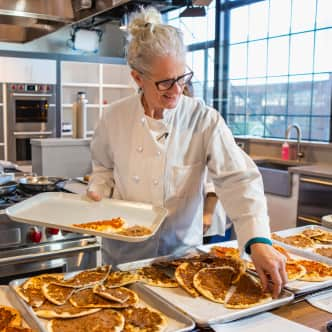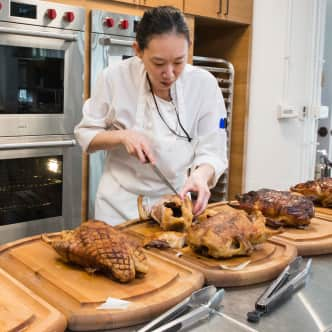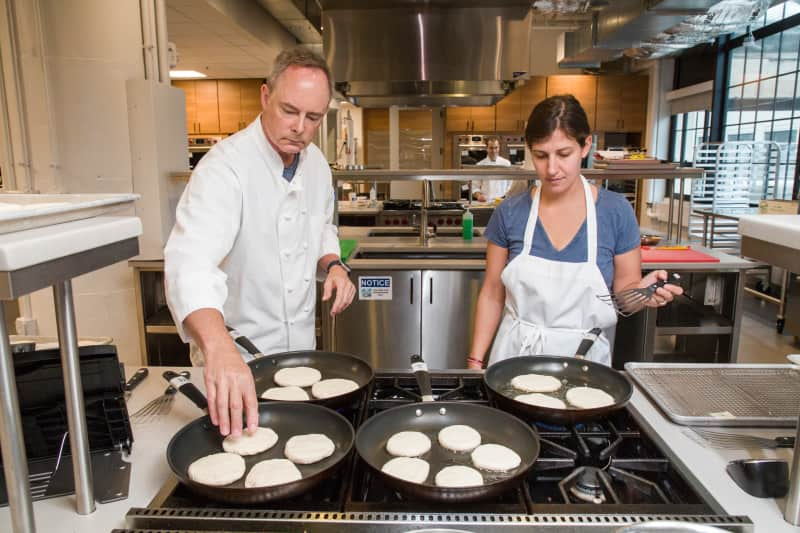In December 2018 I joined America’s Test Kitchen as a test cook for the books team. Over the next few years I developed recipes for dozens of cookbooks, from salads and five-ingredient dinners to chocolate desserts.
The Recipe Test That Sets America’s Test Kitchen Apart
Published Sept. 20, 2023.

Some recipes were “tweaks,” where I modified popular ATK recipes to accommodate a cookbook’s specific guidelines, such as dietary restrictions and serving size.
But most recipes I developed were brand new. And every new ATK recipe starts with what we call a five-recipe test.
Sign up for the Notes from the Test Kitchen newsletter
Our favorite tips and recipes, enjoyed by 2 million+ subscribers!
What’s a Five-Recipe Test?
A five-recipe test is when an ATK test cook prepares five different versions of the same dish and tastes them side by side with their team. It’s a weeks-long process that requires hours of research, cooking, and analyzing.
Why go through all the trouble? Because it’s necessary. It’s what makes our recipe development process more rigorous than any other cooking resource out there.
The five-recipe test allows our test cooks to become fully immersed in the dish. Flavors, textures, techniques, and even mishaps are discovered. Only after we learn the strengths, weaknesses and stumbling blocks of existing recipes do we start creating our own version from scratch.
One of my most memorable five-recipe tests was for my Chocolate-Cardamom Cake with Roasted Pears. It was my first time baking five various cakes at the same time. It was no small feat.
Don’t get me wrong. I didn’t just wake up one day and throw on an apron. In fact, it was weeks before I even set foot in the kitchen.
[A five-recipe test] forces me to look beyond my preconceptions and my experience. It prevents me from being complacent, from thinking that I already know all the answers.
Step 1: Research
It started in the ATK research library, where we house more than 5,000 books and magazines. For weeks I dove into every piece of information I could find about chocolate pear cakes. Over time I managed to collect more than 20 chocolate pear cake recipes from cookbook authors, online sources, and subject matter experts. Twenty!
Research is the most important step in the five-recipe test process. You’re casting a wide net into a sea of recipe information. More importantly, you’re learning.
Cook’s Illustrated Deputy Food Editor Andrea Geary summed it up nicely.
“This research step gives us a broad knowledge base from which to begin. If not for this step, our recipes would be more predictable and parochial,” she said.
With more than 20 recipes splayed across my desk, it was time to choose five to test out.
How does a recipe make the final five? The key is choosing five that demonstrate the range of approaches—in every respect.
- Techniques (cooked vs. raw pears)
- Unusual ingredients (does an orange zest icing pair well?)
- Unusual methods (you want me to drop three whole pears in this cake?)
- Presentation (loaf vs. springform vs. cake pan)
- Popularity (we’re looking at you, trends)
I landed on five recipes from a variety of sources: two cookbooks, one magazine, one blogger, and one famous TV network chef.
Once finalized, it was time to order groceries and head into the kitchen.


From left: Andrea Geary takes part in a five-recipe test for lahmajun. Lan Lam puts the finishing touches on her five-recipe test of whole roast ducks.
Step 2: Cook
Cooking five recipes at a time takes more than one day.
Day one: Prep. Or as chefs call it, mise en place. I spent hours organizing, measuring, and labeling each and every ingredient for each and every cake recipe.
We have more than 25 test cooks at America’s Test Kitchen. Why do this time-consuming step all by myself?
“It’s important [for the test cook] to mise and prepare all the recipes because it keeps [us] honest about the amount of work and skill required for each recipe, which are important considerations,” Andrea said.
With my five cake recipes fully prepped, I was ready to hit the ground running.
Day two: Cook day!
On cook day, there’s one universal rule: Follow each recipe exactly. Even if you're skeptical of it.
I followed each recipe faithfully. I sliced pears to the thickness each recipe called for. I didn’t grease a pan unless the recipe instructed me to. I baked at the temperature it called for, even if it didn’t feel right.
Senior editor of the books team Joe Gitter emphasized the importance of following each recipe verbatim and not his gut.
“It’s easy to put our ATK spin on anyone’s recipe. It almost becomes second nature to assume that [a method or technique] is something we’ve already done, but that’s a definite mistake. The whole point of five-recipe tests is to [test their version] and learn things that we don’t already know.”
Why are we so diligent about this? Because it gives each recipe the best chance of proper representation.

Among the chaos of baking five cakes at once, I took notes on every detail of the experience:
- Did the timing match the visual cues?
- Were the methods confusing?
- What did I struggle with?
- Did something work really well? Or vice versa?
These contributing factors were all taken into account as I started to envision what my own recipe might look like.
But first, it was time to taste.
The Complete ATK TV Show Cookbook
This all-inclusive cookbook is a living archive of every foolproof recipe, bias-free review, and kitchen discovery from America's Test Kitchen, public television's top-rated cooking show.Step 3: Taste
For my cakes, setting up my tasting was simple. Cakes aren’t eaten straight from the oven; they take hours to fully cool. This gave me plenty of time to gather trays, utensils, questionnaires, and anything else I might need for my team to taste.
But that’s not always the case. In fact, most of the time you have to phone a friend or two.
Take a quick-cooking stir-fry, for example. A dish that comes together in minutes is tough to manage when you’ve got five woks on the stovetop.
If that’s the case, Cook’s Country’s Morgan Bolling isn’t afraid to ask for help.
“Often if it’s something quick, I will break it into two tastings (one with three recipes and one with two) and/or employ help from teammates so I can accurately cook all recipes,” she said.

Again, we want to give each recipe proper representation.
Before tasting, I gave my team the full rundown of each cake. I explained the origin of each recipe, the discoveries I made during the baking process, and any issues I came across. It’s important to play Switzerland in the introduction. Swaying tasters before they’ve eaten could skew the results.
When it was time to dig in, it was . . . quiet. In a good way!
Through the forkfuls of chocolate pear cakes, my team filled out a questionnaire I put together. Questions/comments included:
- Rank from favorite to least favorite.
- Describe flavors, textures, and appearance.
- Love something? Why? Hate something? Why?
- If you could combine one recipe with another, which would they be? Why?
- What is your ideal version of this dish?
With our questionnaires and bellies full, we moved on to the next step in the process: analyzing all of the cooking and tasting that had happened up to that point.
Step 4: Analyze
I begin every post-tasting discussion with the same question.
“Did anyone have a favorite?”
Most hands, if not all, are raised. And as Cooks Illustrated Senior Editor Anne Petito says, that’s a good thing.
“We always hope to find a dish or two that strikes a chord with the team (in a good way) that we can use as a starting point for development.”

Once we establish a favorite or two, we discuss imperative takeaways that will help the test cook envision a starting point. Examples include:
- Promising tastes/textures/flavors/presentation
- Variables that need to be tested (and re-tested)
- Were challenging techniques worth it?
- What and how we’d do things differently
- How can we make it the most accessible for a home cook
Making it accessible for the home cook is one of the most important considerations. Can we avoid finicky equipment and expensive ingredients? Can we minimize the number of dirty dishes? Can we address any potential safety hazards?
With pages full of information and feedback, I headed back to my desk to assemble version one of my chocolate pear cake recipe.
Step 5: Start Developing My Own Recipe!
Based on my team’s feedback, there were a few things we were set on. We wanted a single-layer, springform pan cake. We wanted to cook the pears before adding them to the cake to avoid too much moisture. We wanted to make it aesthetically pleasing. (No frosting necessary.)
Most of all, we wanted to make it delicious.
So began the test-and-critique step of recipe development. I’d bake a cake and then get feedback from my team.
Over the following month I baked more than 40 chocolate pear cakes.
Many of them were part of additional side-by-side tastings, specifically looking at elements such as:
- Chocolate: chopped chocolate vs. cocoa powder vs. both
- Pears: roasted vs. poached vs. sautéed
- Various ways to slice and design the cooked pears
- Various oven temperatures and oven rack locations
- Leaveners: baking powder vs. baking soda vs. both
- Cardamom: ¼ vs. ½ vs. ¾ vs. 1 teaspoon
- Lining the springform pan with parchment paper vs. without it
- Make-ahead options (Yes, we ate two-, three-, four-, and five-day-old cakes. For science!)

It might sound like a lot of work. And it is. But, at America’s Test Kitchen, we are Type A passionate foodies who geek out over the science of cooking. Our number one goal is to develop recipes that, if followed exactly, are failproof. We make the mistakes so that you don’t have to.
So that you, instead, can enjoy a slice of Chocolate-Cardamom Cake with Roasted Pears with pride. And without fail.

